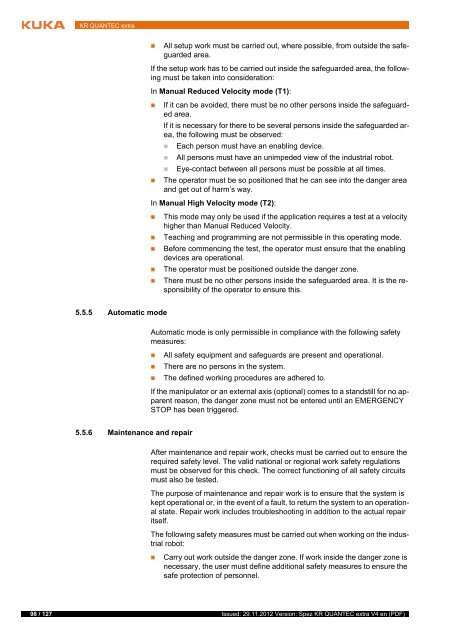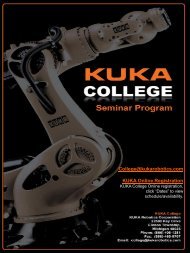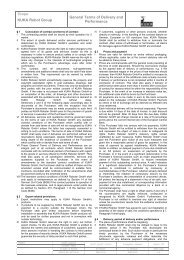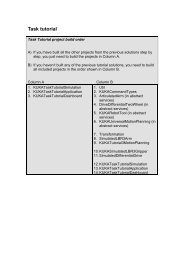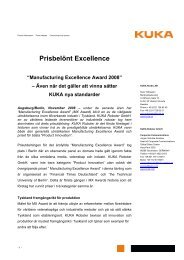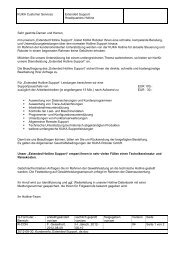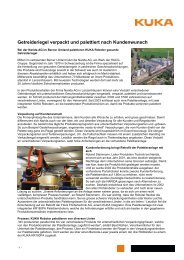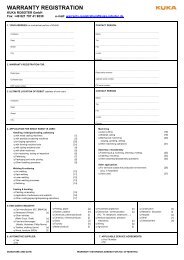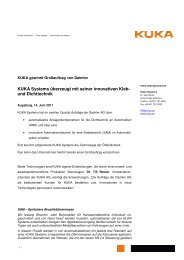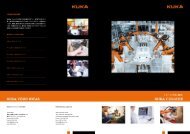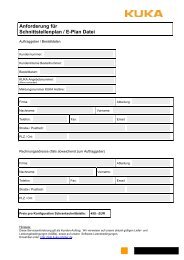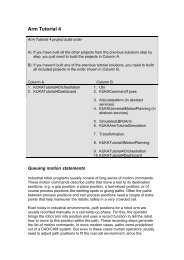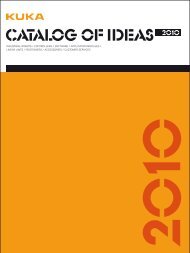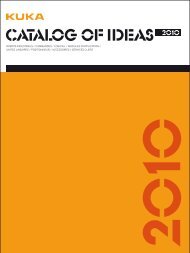KR QUANTEC extra - KUKA Robotics
KR QUANTEC extra - KUKA Robotics
KR QUANTEC extra - KUKA Robotics
Create successful ePaper yourself
Turn your PDF publications into a flip-book with our unique Google optimized e-Paper software.
<strong>KR</strong> <strong>QUANTEC</strong> <strong>extra</strong><br />
5.5.5 Automatic mode<br />
5.5.6 Maintenance and repair<br />
All setup work must be carried out, where possible, from outside the safeguarded<br />
area.<br />
If the setup work has to be carried out inside the safeguarded area, the following<br />
must be taken into consideration:<br />
In Manual Reduced Velocity mode (T1):<br />
If it can be avoided, there must be no other persons inside the safeguarded<br />
area.<br />
If it is necessary for there to be several persons inside the safeguarded area,<br />
the following must be observed:<br />
Each person must have an enabling device.<br />
All persons must have an unimpeded view of the industrial robot.<br />
Eye-contact between all persons must be possible at all times.<br />
The operator must be so positioned that he can see into the danger area<br />
and get out of harm’s way.<br />
In Manual High Velocity mode (T2):<br />
This mode may only be used if the application requires a test at a velocity<br />
higher than Manual Reduced Velocity.<br />
Teaching and programming are not permissible in this operating mode.<br />
Before commencing the test, the operator must ensure that the enabling<br />
devices are operational.<br />
The operator must be positioned outside the danger zone.<br />
There must be no other persons inside the safeguarded area. It is the responsibility<br />
of the operator to ensure this.<br />
Automatic mode is only permissible in compliance with the following safety<br />
measures:<br />
All safety equipment and safeguards are present and operational.<br />
There are no persons in the system.<br />
The defined working procedures are adhered to.<br />
If the manipulator or an external axis (optional) comes to a standstill for no apparent<br />
reason, the danger zone must not be entered until an EMERGENCY<br />
STOP has been triggered.<br />
After maintenance and repair work, checks must be carried out to ensure the<br />
required safety level. The valid national or regional work safety regulations<br />
must be observed for this check. The correct functioning of all safety circuits<br />
must also be tested.<br />
The purpose of maintenance and repair work is to ensure that the system is<br />
kept operational or, in the event of a fault, to return the system to an operational<br />
state. Repair work includes troubleshooting in addition to the actual repair<br />
itself.<br />
The following safety measures must be carried out when working on the industrial<br />
robot:<br />
Carry out work outside the danger zone. If work inside the danger zone is<br />
necessary, the user must define additional safety measures to ensure the<br />
safe protection of personnel.<br />
98 / 127 Issued: 29.11.2012 Version: Spez <strong>KR</strong> <strong>QUANTEC</strong> <strong>extra</strong> V4 en (PDF)


